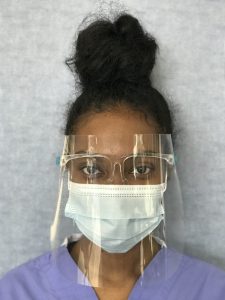Eye Protection
Eye protection includes face shields, visors attached to masks, and goggles that are used to protect the eyes of healthcare providers and may be disposable or reusable. Eye protection should be worn by healthcare providers when procedures or care activities are likely to cause splashing, spraying of body fluids, or when within 2 metres of a coughing client. Eyeglasses can be worn under face shields or goggles. If eye protection is reusable, it should be cleaned before reuse. Face shields and visors attached to masks offer better visibility than goggles. Eye protection should allow for visual acuity, and fit comfortably and securely (PIDAC, 2012).
Points of Consideration: Face Shields
Face shields can be used as an alternative to goggles, and should cover the sides of the face and extend to just below the chin. Face shields are not meant to replace wearing a mask.

Medical mask and goggles |

Medical mask and face shield |
Important Considerations when Wearing Eye Protection
Points of Consideration: If a Person Wears Glasses
Prescription eyeglasses are not considered eye protection on their own, because protection must extend around the sides of the eyeglasses as well as the front.
Clinical Tips
How to prevent fogging of prescription eyeglasses when wearing a mask
To help prevent prescription eyeglasses from fogging up while wearing a mask, ensure that the eyeglasses are resting on top of the nosepiece of the mask. Another technique is to place tape across or down the bridge of the nose with waterproof tape, which may also help to prevent glasses from fogging.

